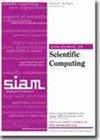A Numerical Method for the Stability Analysis of Linear Age-Structured Models with Nonlocal Diffusion
IF 2.6
2区 数学
Q1 MATHEMATICS, APPLIED
引用次数: 0
Abstract
SIAM Journal on Scientific Computing, Volume 46, Issue 2, Page A953-A973, April 2024.Abstract. We numerically address the stability analysis of linear age-structured population models with nonlocal diffusion, which arise naturally in describing dynamics of infectious diseases. Compared to Laplace diffusion, models with nonlocal diffusion are more challenging since the associated semigroups have no regularizing properties in the spatial variable. Nevertheless, the asymptotic stability of the null equilibrium is determined by the spectrum of the infinitesimal generator associated with the semigroup. We propose a numerical method to approximate the leading part of this spectrum by first reformulating the problem via integration of the age-state and then by discretizing the generator combining a spectral projection in space with a pseudospectral collocation in age. A rigorous convergence analysis proving spectral accuracy is provided in the case of separable model coefficients. Results are confirmed experimentally and numerical tests are presented also for the more general instance. Reproducibility of computational results. This paper has been awarded the “SIAM Reproducibility Badge: Code and data available” as a recognition that the authors have followed reproducibility principles valued by SISC and the scientific computing community. Code and data that allow readers to reproduce the results in this paper are available at https://gitlab.com/SIMONE.DEREGGI/agenonlocig and in the supplementary materials (DE_REGGI_M156897R_codes.zip [16KB]).
非局部扩散线性年龄结构模型稳定性分析的数值方法
SIAM 科学计算期刊》,第 46 卷第 2 期,第 A953-A973 页,2024 年 4 月。 摘要我们用数值方法分析了具有非局部扩散的线性年龄结构种群模型的稳定性。与拉普拉斯扩散相比,非局部扩散模型更具挑战性,因为相关半群在空间变量中没有正则化特性。然而,空平衡的渐进稳定性是由与半群相关的无穷小发电机的频谱决定的。我们提出了一种近似该频谱前沿部分的数值方法,首先通过年龄状态积分重新表述问题,然后结合空间谱投影和年龄伪谱配位对生成器进行离散化。在模型系数可分离的情况下,提供了严格的收敛分析,证明了频谱的准确性。实验证实了结果,并对更一般的情况进行了数值测试。计算结果的可重复性。本文被授予 "SIAM 可重现徽章":代码和数据可用",以表彰作者遵循了 SISC 和科学计算界重视的可重现性原则。读者可在 https://gitlab.com/SIMONE.DEREGGI/agenonlocig 和补充材料(DE_REGGI_M156897R_codes.zip [16KB])中获取代码和数据,以便重现本文的结果。
本文章由计算机程序翻译,如有差异,请以英文原文为准。
求助全文
约1分钟内获得全文
求助全文
来源期刊
CiteScore
5.50
自引率
3.20%
发文量
209
审稿时长
1 months
期刊介绍:
The purpose of SIAM Journal on Scientific Computing (SISC) is to advance computational methods for solving scientific and engineering problems.
SISC papers are classified into three categories:
1. Methods and Algorithms for Scientific Computing: Papers in this category may include theoretical analysis, provided that the relevance to applications in science and engineering is demonstrated. They should contain meaningful computational results and theoretical results or strong heuristics supporting the performance of new algorithms.
2. Computational Methods in Science and Engineering: Papers in this section will typically describe novel methodologies for solving a specific problem in computational science or engineering. They should contain enough information about the application to orient other computational scientists but should omit details of interest mainly to the applications specialist.
3. Software and High-Performance Computing: Papers in this category should concern the novel design and development of computational methods and high-quality software, parallel algorithms, high-performance computing issues, new architectures, data analysis, or visualization. The primary focus should be on computational methods that have potentially large impact for an important class of scientific or engineering problems.

 求助内容:
求助内容: 应助结果提醒方式:
应助结果提醒方式:


